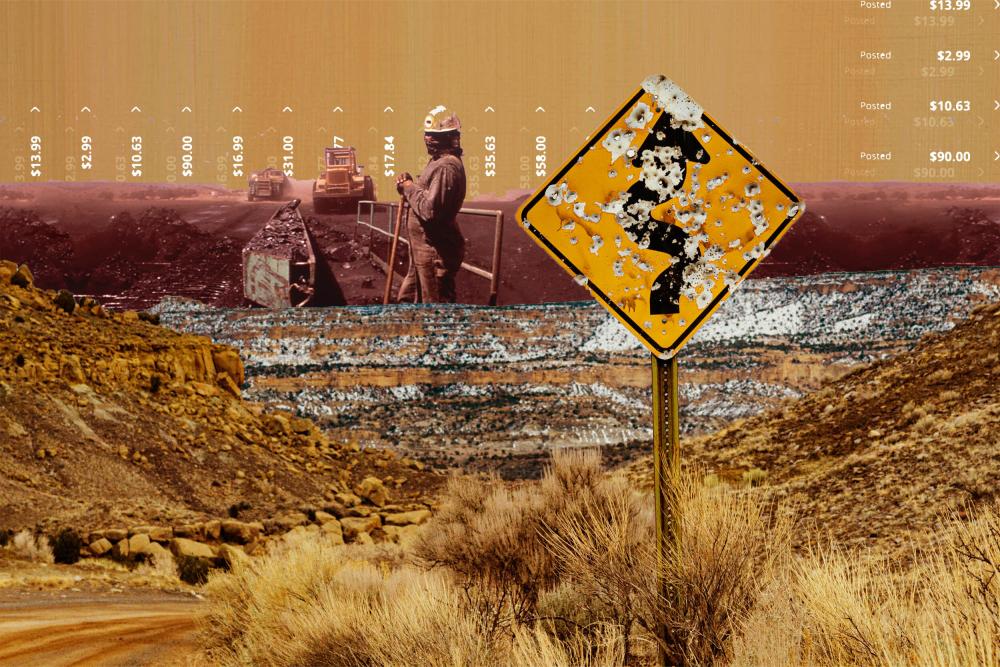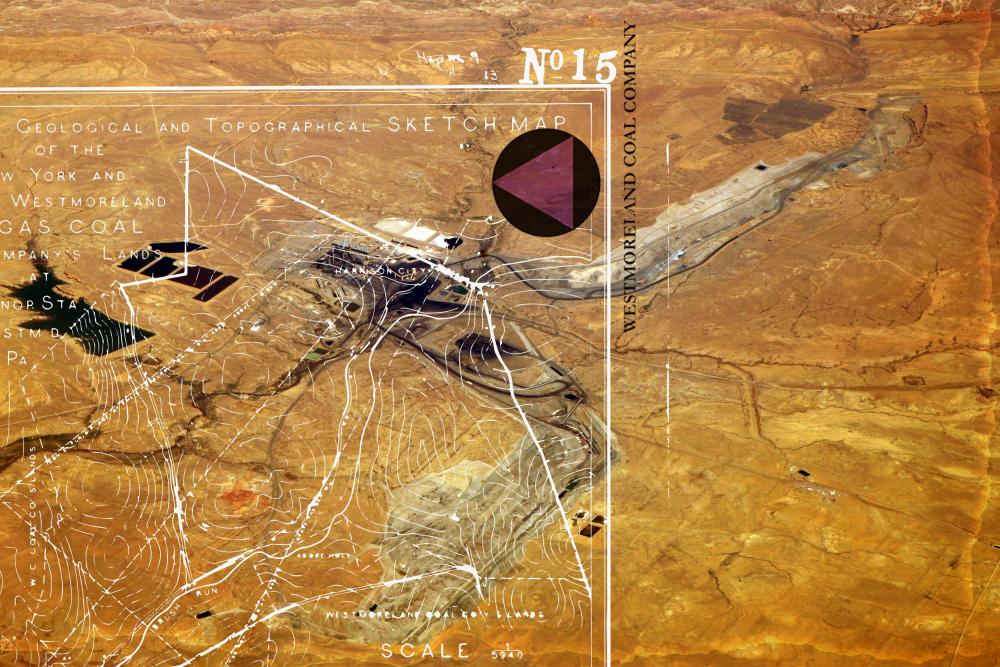In early 2022, the San Juan coal mine outside of Farmington, New Mexico, was preparing to shut down, along with the coal-fired power plant it fed. Meanwhile, Dave and a small crew continued to work underground, running the machinery that extracted the coal. But it wasn’t going well: “Everything that could go wrong did,” he said. (“Dave” is a pseudonym; he asked that his real name not be used, since he continues to work in the coal industry.)
San Juan was a longwall mine, meaning that its coal was extracted by a colossal shearing machine that worked back and forth across an exposed panel of coal, like a deli slicer shaving off wedges of ham. An internal memo said the mine’s final coal panel had “difficult geologic conditions like nothing we had ever encountered.” A series of hydraulic jacks held up the mine’s ceiling, each jack weighing as much as 40 tons. But at San Juan, the jacks, which were supposed to sit flush with the floor, were tipped precariously back toward the coal seam. Giant rocks twice the size of Greyhound buses obstructed the work zone.
In mining terms, Dave and his coworkers were “iron bound,” meaning that their equipment was stuck in the mine; the machinery on the longwall couldn’t move without colliding. “Every contractor that walked in and saw that longwall face told us to just bury” the equipment, he recalled.
Dave and the remaining miners pulled the last ton of coal out of the San Juan Mine that September. The closure of the mine and plant left him and some 400 other workers — many of them Navajo Nation citizens — without a job, pulling the plug on one of the Four Corner region’s largest economic engines. Even before the closure, a quarter of the people in San Juan County, where the mine was located, were living below the poverty line.
“We look out for each other. With this law, we seal that promise.”
After they were laid off, the miners were supposed to get some financial relief from New Mexico’s Energy Transition Act (ETA), a sweeping climate and renewable energy law with provisions for severance payments and job training for laid-off workers. In a statement after signing the bill, Gov. Michelle Lujan Grisham emphasized that communities that relied on fossil fuel industries would not be left behind. “We look out for each other,” she said. “With this law, we seal that promise.”
But by the time Dave’s last shift ended, the International Union of Operating Engineers Local 953, to which he belongs, was embroiled in a fight with mine owner Westmoreland over the distribution of the ETA funds. The dispute continues today. While most of the power plant workers and some mine employees have received their checks, Dave and other unionized miners either haven’t received a dime or else got a mere fraction of what upper-level management did. New Mexico is indeed transitioning from coal-fired power, but many miners are feeling left behind.
In the San Juan Mine’s final months, Dave and the remaining miners worked to keep it running with what he called “brute force hydraulics and a little bit of luck.” Then, over a weekend, the headgate — the main entrance to the mine — collapsed. At that point, the doomed mine had little time left, but the miners repaired the collapse anyway. “We got that sucker running again,” Dave recalled. “We pulled off not one, not two, but three different miracles.
“We fought it every inch of the way,” he went on. “And so all this ETA stuff was just an extra slap in the face after we did all that work.”

Marissa Garcia/High Country News
THE SAN JUAN GENERATING STATION began churning out power in 1973. In 2017, its operator, Public Service Company of New Mexico (PNM), the state’s largest regulated utility, shut down two of the four units to comply with clean air rules. The power plant was retired altogether in the fall of 2022, prompting the closure of the nearby mine, which existed to feed it.
The Energy Transition Act allowed PNM to issue bonds to finance the costs of energy transition, including everything from closing the power plant to compensating displaced workers. PNM paid its power plant workers directly. And this summer, after extensive delays, the state — through the Department of Workforce Solutions — began the process of paying out more than $20 million in direct financial aid and job training to displaced plant and mine workers.
More than a year before, in March 2022, PNM also transferred $8.8 million to an escrow account, intended for severance payments to workers at the San Juan mine. A financial institution would control the escrow account, but the amounts of those payments and who received them would be guided by data provided by Denver-based Westmoreland.
Each of the approximately 200 workers at the mine stood to get around $40,000 from this chunk of change if it were evenly divided. But it seems that after PNM deposited the money, there was little remaining public oversight on how the money was divided up. That calculation was left up to Westmoreland. And, according to more than 10 interviews with former Westmoreland employees, both union and management, the company decided to use the money to pay its managers significantly more in severance than it paid the laid-off miners.
On the surface, it looks like a simple matter of workplace inequities persisting even after the workplace closes: Since managers get paid more than miners, their severance payments are going to be higher. But the severance payments for the most senior unionized workers, who spent decades in the mine, appear to have topped out at around $35,000. Salaried managers — even those with far fewer years on the job — routinely pulled in well more than double that amount. Nothing in the Energy Transition Act suggests that management should have been favored to this extent — but nothing in the law prevented it, either.
Duane Calhoon, an underground miner who had moved into a management position, confirmed that he received about $78,000 in Energy Transition Act severance from Westmoreland. Eric Hanon, another miner turned salaried employee, voluntarily left Westmoreland before receiving severance, but said that his superiors told him that the standard payout for salaried employees was approximately $84,000. He said that he heard of some other managers who received more than $100,000. Hanon didn’t know how the payout amounts were determined, but his hunch is that favoritism played a role. “It was a good old boy system,” he said. “Most coal mines are. They take care of their buddies.”
“It was a good old boy system. Most coal mines are. They take care of their buddies.”
After the transition payouts from the escrow account began, union officials said they asked Westmoreland to share its calculations for the severance payments, but that the company refused. (Westmoreland also refused to share this information with HCN.) According to Chris Roop, the union’s former master steward, who had worked at the mine for 15 years, the company stonewalled the union. “Over the long timespan talking with Westmoreland,” he said, “that turned into: ‘These are the numbers that we have, and we’re not going to disclose to the union how we came up with these numbers.’”
So, last spring, the union filed a charge with the National Labor Relations Board, accusing Westmoreland of refusing “to bargain with the Union regarding the payment of severance and the provision of job training services for workers laid off.” The complaint claimed that even though the funds came from a publicly regulated utility, Westmoreland was given “sole authority to determine distribution and authorize payment,” adding that the company claimed that the funds were “private money.” In response to a list of questions, Jon Heroux, Westmoreland’s corporate counsel for external affairs, called the allegations “spurious and unfounded” and said that the union “made no formal or informal request to Westmoreland to bargain on this matter.”
“Westmoreland does not have any statutory right to bargain with, control, or administer any of these funds,” he said, adding that the funds were to be administered by PNM, the state-regulated utility.
The agreement for the escrow account suggests that Westmoreland does have some level of control over the funds – in addition to determining the severance amounts paid out to the workers. Signed by a Westmoreland representative, the agreement stated that the coal company and the financial institution that created the escrow account would “work together to facilitate and coordinate disbursement” of the severance money. It also stated that PNM would have “no duties or obligations … relevant to facilitating or coordinating the disbursement of the severance amount.”
This was not the first time Westmoreland favored management at the expense of miners. In 2018, as the company approached Chapter 11 bankruptcy, it paid out $10 million to its top executives while trying to avoid paying health benefits to retirees, according to its bankruptcy filings. Meanwhile, Westmoreland handed out retention pay to 243 employees “critical to the Debtors’ business operations,” who were mostly high-level management, not actual miners.
After the NLRB case was filed, union members said that Westmoreland halted all payouts of the energy transition funds, pending a decision. In his statement, Heroux blamed the union for the delay. “That is why we believe the Union should withdraw this particular case immediately,” he said. “Doing so will help speed up the process of getting funds to all those who rightly deserve them.”
The holdup meant that Dave and his coworkers, who had helped seal the San Juan Mine’s tunnels for good in September 2022, were laid off without receiving the funds specifically set aside to ease their transition away from coal. (Some of the miners have accessed, or are applying for, different Energy Transition Act funds.) Nearly a year and a half after the union’s complaint was filed, the Labor Relations Board is still investigating.

Marissa Garcia/High Country News
SINCE THE MINE’S CLOSURE, most of the miners have found other employment. Hanon drained his 401(k) to purchase a few Freightliners and start a trucking company, which he said is struggling. Dave found another job in mining, at a small non-union operation in southwestern Colorado, across the border from Farmington.
Lisa Kennedy, who worked at the mine for more than two decades, at times with her son and other relatives, told me she and other union members are considering a motion to accept Westmoreland’s severance payout terms at the next union meeting, which is in December. Kennedy, who is known as a hard-liner on the ETA payout issue has long urged the union to keep fighting, but even she is growing weary.
“I’m just tired of waiting and waiting and holding my breath and thinking that something’s going to happen.
“I’m just tired of waiting and waiting and holding my breath and thinking that something’s going to happen,” she said. “It’s shitty money compared to what the company guys are getting, but I’m done with it.”
After he was laid off, Roop became a licensed life insurance salesman. The union’s former master steward comes from a proud line of western Colorado coal miners; at one point, he worked at San Juan alongside his father and grandfather. His current income doesn’t match that of his union job, though his schedule is more flexible now, allowing him more time with his daughter.
In a Farmington coffee shop, Roop, who is stockily built and has a black beard, grew animated discussing the end of the mine. It was once a “proud” place to work, he said, and it meant something to him to work at a place where his father had voted on previous union contracts. “For that mine to have been open for so many years,” he said, “and so many families retire from there, the massive amount of benefits that came out of mine — for it to end the way that it did is really sad.”
Image credits: The San Juan Generating Station, flanked by its surface coal mines near Farmington, New Mexico, in 2012. Doc Searls/CC via Flickr; A geological and topographical sketch map of a Westmoreland mine in 1883. Norman B. Leventhal Map & Education Center/Boston Public Library; A Navajo worker at Peabody Coal Co. in 1972. Environmental Protection Agency; A road sign near Farmington, New Mexico. Adam Cohn/CC via Flickr
Reposted with permission from High Country News
Nick Bowlin is the interim South Desk editor at High Country News. Email him at nickbowlin@hcn.org or submit a letter to the editor. See our letters to the editor policy.

High Country News is an independent, reader-supported nonprofit 501(c)3 media organization that covers the important issues and stories that define the Western United States. Our mission is to inform and inspire people to act on behalf of the West's diverse natural and human communities.


Spread the word